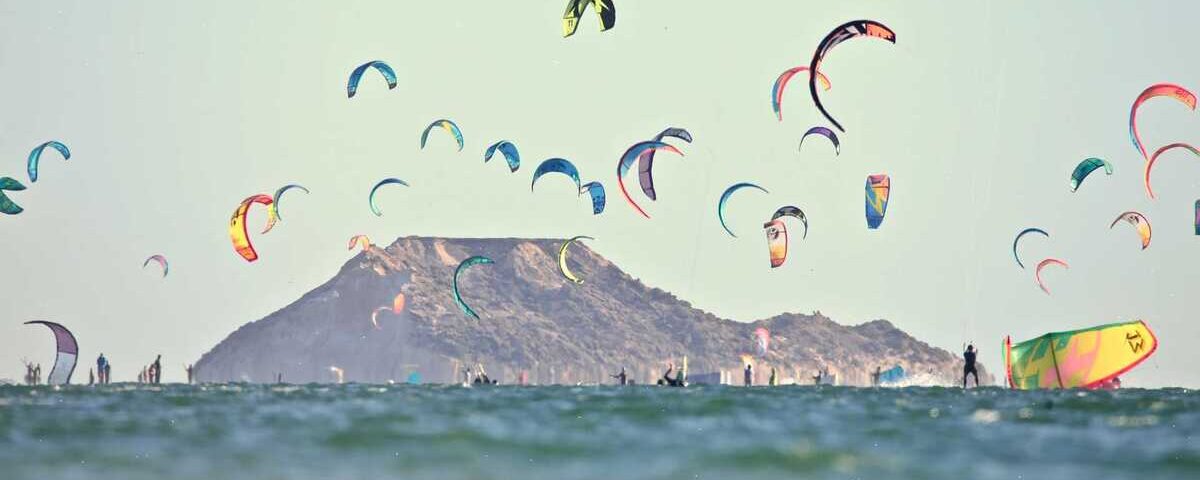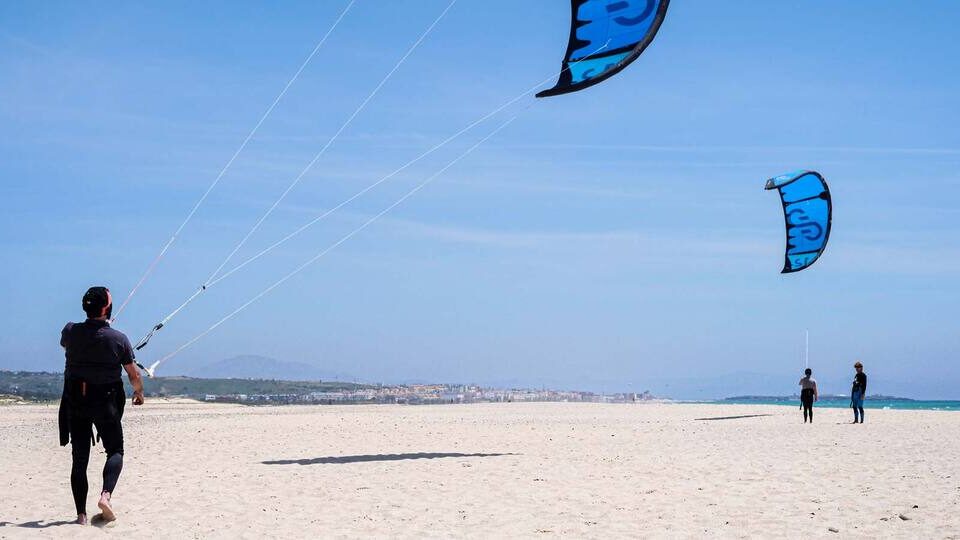Organisation of Dakhla B2B Meeting: Kite Business Meeting

Is Dakhla a dangerous destination?
Kitesurfing is admittedly a fairly expensive sport, but there are solutions to everything! Some destinations offer kite holidays, equipment hire and lessons on a fairly tight budget. Here at Ocean Adventure, we give you THE best places to learn to kite while holidaying in paradise and without breaking the bank.
What will make learning economical is your ability to make progress during a week’s stay. Ideally, you should be practising every day over a period of 5 days in semi-private lessons!
Unknown to the general public just a few years ago, kitesurfing is now at the height of its popularity. Kitesurfing is one of the most popular water sports. More and more windsurfers and surfers are taking up the sport. For them, the search for the best spots to kite has become a second passion. The good news is that there are plenty of them along Europe’s coasts. On the Canaries, in Spain or even on the Moroccan borders. Here’s a closer look at the top 6 best spots in Europe to start kitesurfing.
Contenus de la page
1. Morocco: Dakhla lagoons & Essaouira bay
Dakhla, Morocco’s kitesurfing paradise
If you’re thinking of taking up kitesurfing, Dakhla is the destination of choice. In this Moroccan paradise where the wind blows 300 days a year, all water sports activities are permitted.
With several spots enjoying an excellent international reputation, the former Villa Cisneros promises optimal wind conditions. However, it’s worth paying attention to the seasonality of the wind, especially when you’re just starting out. From March to November, there’s every chance of enjoying the wind almost every day. For experienced kitesurfers, the summer season is the best time for strong, constant wind.
As you’ll have gathered, Dakhla is a town packed with kitesurfing camps. More often than not, the favourite spots for apprentice kitesurfers are around the lagoon. This allows them to be closer to their mentors, so they can learn this fast-paced sport quickly.
Essaouira Bay, learn and progress in an idyllic setting
Here are some good reasons to choose this Moroccan destination as your first kitesurfing destination:
– World-renowned spots;
– Windy conditions rarely found elsewhere;
– Kiteboarding in the middle of camels.
Just a two-hour drive from Marrakech and Agadir, this destination fully meets the criteria of up-and-coming kitesurfers going away with their families. Its spot is made up of a bay of more than 3 km of sand, to the delight of young and old alike. The water is pleasant, while the town is friendly. For a wilder side, camels and horses rub shoulders with kitesurfers on the beach. The bay of Essaouira is undoubtedly the preferred setting for water sports enthusiasts keen to get off the beaten track and experience authenticity. What’s more, the wind that blows almost all year round provides ideal conditions for learning board sports, including kitesurfing.
2. Spain: Tarifa & Fuerteventura
Corralejo, Flagbeach beach
Without leaving the charismatic Corralejo, Flag Beach is just outside the town. The reputation of this spot is well established, both on Fuerteventura and in Europe. You’ll find a huge beach with fine sand, leading directly onto a vast expanse of turquoise water. Unlike Majanicho, the waves here are lower. Generally speaking, the most experienced surfers are the main ones at this spot, but beginners can also enjoy the clear waters with proper supervision. It is strongly recommended that you prefer high tide to avoid the inconvenience caused by small pebbles getting tangled up in the sand. A word of warning: this spot is crowded during the kitesurfing season.
Sotavento: for freestyle kiteboarders
Sotavento enjoys a favourable geographical position thanks to the two hills that surround it. These create a sort of natural corridor, channelling and amplifying the north-westerly trade winds that come from the off-shore sides. Thanks to this location, conditions are ideal for gliding across the water, guided by the wind and the waves. For experienced kitesurfers, the experience of surfing in the open sea is sensational. An adrenalin rush is to be expected! As for beginners who come to the Canaries to discover this discipline, a small lagoon forms at high tide. However, Sotavento is suitable for all types of surfer.
If you want to venture out to Fuerteventura on your surfboard, the best time to plan your trip is from December to May. This is the period of the trade winds and you can expect 15-20 knots on average.
Tarifa: world-class spots
Tarifa is the place that Mother Nature chose for the meeting of the Mediterranean Sea and the Atlantic Ocean. Thanks to its location at the tip of Andalusia and right on the edge of continental Europe, it’s considered to be the Spanish Mecca of kitesurfing. The wind is omnipresent, both very strong and dominant. In fact, the warm, dry Levante is what makes this destination so famous. This wind comes from the East. The wind from the west is called the Poniente. More constant, it is most often accompanied by a thermal effect, particularly during the summer season. A real treat for kitesurfing fans!
If you want to learn to kitesurf in Tarifa, there are several spots to choose from. The best-known are Bolonia, a must for freeriding, Punta Paloma, excellent for wave and freestyle, and Balneario, suitable above all for experts. It’s worth pointing out, however, that kiting is forbidden in summer at most of Tarifa’s spots.
3. Portugal
Lagoa de Albufeira, a spot with perfect conditions
Just 45 minutes from Lisbon, this is surely one of the country’s most charismatic spots, and as luck would have it, also promises an unrivalled playground for kitesurfers. This is where you’ll experience the best kitesurfing sessions of your life. Swept by the west wind, the beach is synonymous with peace. In fact, thanks to the north-westerly wind coming directly from the sea, you’ll be able to sail in all directions. This is made possible by the shallow waters of the lagoon.
Unique of its kind, the Albufeira lagoon is a highly regarded ecological zone. In fact, it’s the perfect blend of salt water from the Atlantic and fresh water from the River Apostiça. More than just a spot dedicated exclusively to kitesurfers, Lagoa de Albufeira is also a vast beach lined with pine forests, a must for walkers.
Beware, however, of the fishermen who are very present in the middle of the lagoon. Also, the tides require special attention as the lagoon overlooks the ocean.
Fonte da Telha, a wave spot for beginners
We’re talking about a small fishing village that transforms itself into a real seaside resort during the summer season. Fonte de Telha is a little corner of paradise less than 30 minutes from Lisbon. It’s a lively spot, with many bars and restaurants lining the beaches.
For lovers of board sports, kitesurfing is particularly popular here. There are even several kitesurfing schools offering tailor-made tuition for beginners. After all, the spot’s wind conditions are excellent, making it more accessible to amateurs. But that doesn’t stop the professionals from the GKA Kitesurf World Tour from training here in the afternoons. In fact, the north-westerly wind that dominates this coastal area is particularly strong in the late afternoon.
Another advantage of this spot is that there are plenty of car parks in the vicinity. This is an important detail if you’re going to be travelling with your board and sail, unless you plan to hire one locally. This is a perfectly feasible alternative.
Praia do Guincho, kitesurfing in the spotlight
More than 800 metres long, this magnificent beach is less than 35 minutes from the capital. If you’re staying in Cascais, Praia de Guincho can be reached in just 10 minutes. This is the second most popular kitesurfing spot in Portugal, just after the Obidos lagoon. Its main strength? Powerful gusts of up to 100km/h. It’s even proving difficult to take a leisurely stroll along its beaches. In fact, windless days are virtually non-existent.
In general, the prevailing winds in this part of Portugal oscillate between north-westerly and westerly. As far as the onshore winds are concerned, they are released directly onto the beach after rushing in through a sort of funnel. Because of the strength of the gusts, you need to be extra careful with the waves, which can be up to 2 metres high. The same applies to high tides. If you’re a beginner, we strongly recommend that you seek professional guidance.
Tip: the northern beach of Guincho is best suited to kitesurfers, as the other parts are popular playgrounds for surfers and bodyboarders.
Lagoa de Óbidos, Portugal’s number 1 kitesurfing spot
All board sports fans know that the Obidos lagoon is the highlight of a kitesurfing holiday in Portugal. Just 30 minutes from Péniche and less than 1h30 from the capital, it is the country’s largest lagoon. Salt water from the ocean and fresh water feed this 6km-long mirror. Lagoa de Obidos actually has two main spots. The first is the estuary to the west of the lagoon. This is a popular spot for wave-skiers. They enjoy crossing the estuary to reach the ocean. However, this spot is closed to kitesurfers in summer.
If you want to kite all year round, the second spot, ‘inside the lagoon’, is the place to go. With north-westerly and northerly winds blowing off the beaches, you can sail in all directions. The only drawback is that the take-off zone is slightly narrow. For beginners, a good accompaniment is required. In any case, it’s rare to find elsewhere a playground as excellent as Lagoa de Obidos.
What’s more, the spot is renowned for its seabed full of molluscs and fish of all species. Aquatic flora also find favourable shelter in its shallow waters. The lagoon is also surrounded by lush vegetation.
4. Cape Verde, idyllic conditions for kitesurfing
The island of Sal: idyllic conditions for kitesurfing
The beauty of its landscapes, combined with the unique quality of its waves, has made the island of Sal one of the most popular spots for kitesurfing enthusiasts. Running along the west coast of Africa, this archipelago of Cape Verde is home to some world-renowned sites.
Taking wind statistics into account, Sal tops the list of ultimate destinations for learning or perfecting kitesurfing. However, the windy season runs from October to June. It’s the perfect time to take it easy. For kitesurfers looking for excellent swells, the best period is from December to April. Conditions are optimal for Waves Rides.
Sal Rei Bay: exploring the island of Boa Vista
Cape Verde is undoubtedly spoiled by Mother Nature, with its spots resembling veritable terrestrial paradises. For kitesurfers, the Sal Rei Bay is strategically located. They can take advantage of flat to choppy conditions.
Freeride aficionados will be in heaven as they travel the 2km between the shore and the island of Sal Rei. A breath of fresh air guaranteed!





